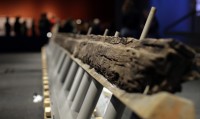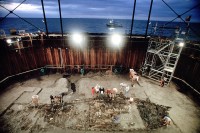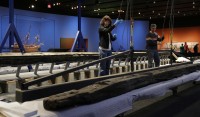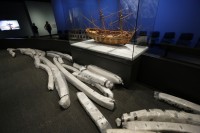 The wreck of La Belle, one of explorer Rene-Robert Cavelier Sieur de La Salle’s supply ships, is on view to the public now, 328 years after it sank in Matagorda Bay and 17 years after it was recovered from the sea floor.
The wreck of La Belle, one of explorer Rene-Robert Cavelier Sieur de La Salle’s supply ships, is on view to the public now, 328 years after it sank in Matagorda Bay and 17 years after it was recovered from the sea floor.
When the 54-1/2-foot frigate went down in a storm in the Gulf of Mexico in 1686, it was packed with supplies to support a French colony at the mouth of the Mississippi and a planned military expedition into Mexico. Neither of those two aims were achieved. When the wreck was found by Texas Historical Commission archaeologists in 1995, the bottom third of the ship’s oak hull was completely intact. To keep this marvel of preservation together, the recovery team built a cofferdam around the wreck, pumped out all the water and excavated the hull from six feet of mud. After two years, the excavation retrieved the remains of the ship and more than 1.6 million artifacts including 21,500 pounds of gunpowder, cannons, muskets, cooking vessels and navigational tools. Whole crates were found full of an enormous quantity of trade goods, including 1,571
archaeologists in 1995, the bottom third of the ship’s oak hull was completely intact. To keep this marvel of preservation together, the recovery team built a cofferdam around the wreck, pumped out all the water and excavated the hull from six feet of mud. After two years, the excavation retrieved the remains of the ship and more than 1.6 million artifacts including 21,500 pounds of gunpowder, cannons, muskets, cooking vessels and navigational tools. Whole crates were found full of an enormous quantity of trade goods, including 1,571  brass Jesuit rings, 17,000 brass pins, 664 axe heads, and 618,000 glass beads strung together by color.
brass Jesuit rings, 17,000 brass pins, 664 axe heads, and 618,000 glass beads strung together by color.
The ship’s hull was sent to the Conservation Research Laboratory at Texas A&M where it was soaked in polyethylene glycol (PEG), a polymer that replaces water in wood and keeps it from drying out or warping. After 15 years in PEG, the timbers were moved to a custom-built freeze dryer 40 feet long and eight feet wide where the process of drying them out without damage could be accomplished faster and cheaper.
 This summer the timbers were transported from Texas A&M to the Bullock Texas State History Museum in Austin. On October 25th, reassembly of the hull began in full public view at the museum. Visitors can watch La Belle rise again and interact with the archaeologists, asking questions as they work.
This summer the timbers were transported from Texas A&M to the Bullock Texas State History Museum in Austin. On October 25th, reassembly of the hull began in full public view at the museum. Visitors can watch La Belle rise again and interact with the archaeologists, asking questions as they work.
More than 100 artifacts and a live-action reassembly tell a story that was lost at sea for 300 years. Discover what items 17th century French settlers thought were important enough to transport across the ocean to establish a new North American colony. Artifacts such as brass kettles, cooking utensils, and carpentry and farming tools shed light on both European domestic culture and future colony planning. Colored beads and other trade goods perhaps speak to strategies for interacting with American Indians. An iconic La Belle artifact,
the bronze cannon, tells more than a military story. It was the carved dolphin handles, along with other cannon insignia, that helped historians determine that the wreckage they had discovered was indeed La Belle. A replica of the ship pinpoints where the artifacts were found during excavation. For a once-in-a-lifetime experience, watch up-close inside the gallery as the ultimate artifact of the exhibition, the ship itself, rises again as experts reassemble the vessel, timber by timber.
 Assembly is expected to be completed by May of next year, so you have seven months to see the ship come together before the hull is encased in a glass structure that will allow people to walk on the ship and experience the feeling of being on deck looking down into the cargo hold.
Assembly is expected to be completed by May of next year, so you have seven months to see the ship come together before the hull is encased in a glass structure that will allow people to walk on the ship and experience the feeling of being on deck looking down into the cargo hold.
What I find amazing is how small that thing is. How on earth did they pack all the stuff found in it, including powder and guns, plus food and water for the voyage, plus enough room for what must have been a crew of at least several dozen?
The story is probably even more interesting than the wrecked ship itself. Knowing hardly anything about Texas, but having read about the French colonization of Texas on W’Pedia, I cannot help but wonder how many expeditions to all kinds of places were probably made over the centuries that nobody ever heard from again.
Here, the mix of Spanish, French and English placenames -plus the Indian ones- does not make it easier to follow. Apparently, setting sail from Santo Domingo, the plan had been to aim at the Mississippi River delta, but instead they ended up in what is now Texas due to miscalculation of the latitude of the mouth of the Mississippi River and overcorrection for the currents. Some maps: An earlier one from 1681 and a later one depicting Matagorda_Bay (a.k.a. San Bernardo Bay) from 1689.
P.S.: Playing cards from Nuremberg, ca. 1535. Among the remarkably multinational ‘kings‘, the ‘king of diamonds’ on the far right seems to be an ‘indian’ one with a warrior – without doubt, the elephant must be an ‘indian’ one.
And look under/behind the king of hearts: tepees.
The globes at the top corner of the king of diamonds look amazingly like the kerosene “warning, roadwork” devices used at night that I dimly remember from my youth.
Correction– the timbers were not soaked in PEG. Although that has been the standard for wood fiber preservation, soaring oil prices in 2000 made that impossibly expensive, it was cheaper to custom build the gigantic freeze dryer.
A bonus is that the timbers do not have the slight sheen you get from PEG (though do still maintain a faint whiff of coastal mud stank).
I got to go see the exhibit right before it officially opened, as a Texas Archeological Society special thing. The pins are impossibly tiny, the preserved detail on rings, crucifix, forks, and wax seal amazing. One interesting thing is no iron survives- the salt water caused the iron to precipitate out as an oxide that formed conceptions with an exact mold of the piece in the center- such that they were able to pour epoxy in the hole and then get spear heads, cannons, and flintlock gun pieces (so accurate that the casts could be fit into the spot of the iron fittings on the wood stock of the guns- quite neatly).
They were soaked in PEG for years at the Texas A&M Riverside campus until skyrocketing oil prices drove made the costs prohibitive. The freezer only came into play in 2010.
More like 16th Century Ottoman Army tents than teepees. IMHO anyway. But then the Turks have always claimed to be cousins of the plains Indians of America.